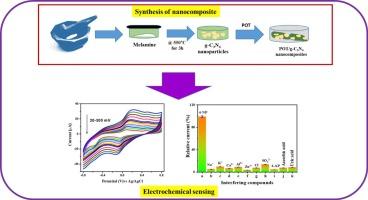Metal-free poly(o-toluidine)/g-C3N4 nanocomposite for efficient electrochemical sensing of 4-nitrophenol
IF 5.1
3区 材料科学
Q2 MATERIALS SCIENCE, COATINGS & FILMS
引用次数: 0
Abstract
Developing highly sensitive electrodes remains a challenge for contemporary environmental monitoring systems. This study addresses this limitation by fabricating electrochemical sensors based on a novel conducting polymer nanocomposites. The poly(o-toluidine) (POT)/g-C3N4 nanocomposite was synthesized via in situ chemical oxidative polymerization using ammonium peroxydisulfate as the oxidant and camphor sulfonic acid (CSA) as the dopant. Comprehensive characterization, including FTIR, FESEM, and HRTEM analyses, confirmed the interaction between POT and g-C₃N₄ and revealed a ring-like morphology with a thin CSA-doped polymer layer. Differential pulse voltammetry (DPV) with a modified glassy carbon electrode modified by the CSA-doped POT/g-C3N4 nanocomposite was used to detect 4-nitrophenol. Under optimized conditions, the sensor exhibited a linear detection range of 0.0025–0.140 μM, a sensitivity of 15.32 μA μM−1 cm−2, And a detection limit (LOD) of 0.00769 μM or 7.69 nM. The modified electrode showed satisfactory recovery rates and robust stability in real sample analyses, demonstrating its potential for practical environmental pollutant detection.

无金属聚(邻甲苯胺)/g-C3N4纳米复合材料对4-硝基苯酚的高效电化学传感
开发高灵敏度电极仍然是当代环境监测系统面临的一个挑战。本研究通过制造基于新型导电聚合物纳米复合材料的电化学传感器来解决这一限制。以过氧二硫酸铵为氧化剂,樟脑磺酸(CSA)为掺杂剂,采用原位化学氧化聚合法制备了聚邻甲苯胺(POT)/g-C3N4纳米复合材料。通过FTIR、FESEM和HRTEM等综合表征,证实了POT与g-C₃N₄之间的相互作用,并揭示了一层薄的csa掺杂聚合物层的环状结构。采用csa掺杂的POT/g-C3N4纳米复合材料修饰的玻碳电极差分脉冲伏安法(DPV)检测4-硝基苯酚。在优化条件下,传感器的线性检测范围为0.0025 ~ 0.140 μM,灵敏度为15.32 μA μM−1 cm−2,检出限(LOD)为0.00769 μM或7.69 nM。该修饰电极在实际样品分析中表现出令人满意的回收率和良好的稳定性,显示了其在实际环境污染物检测中的潜力。
本文章由计算机程序翻译,如有差异,请以英文原文为准。
求助全文
约1分钟内获得全文
求助全文
来源期刊

Diamond and Related Materials
工程技术-材料科学:综合
CiteScore
6.00
自引率
14.60%
发文量
702
审稿时长
2.1 months
期刊介绍:
DRM is a leading international journal that publishes new fundamental and applied research on all forms of diamond, the integration of diamond with other advanced materials and development of technologies exploiting diamond. The synthesis, characterization and processing of single crystal diamond, polycrystalline films, nanodiamond powders and heterostructures with other advanced materials are encouraged topics for technical and review articles. In addition to diamond, the journal publishes manuscripts on the synthesis, characterization and application of other related materials including diamond-like carbons, carbon nanotubes, graphene, and boron and carbon nitrides. Articles are sought on the chemical functionalization of diamond and related materials as well as their use in electrochemistry, energy storage and conversion, chemical and biological sensing, imaging, thermal management, photonic and quantum applications, electron emission and electronic devices.
The International Conference on Diamond and Carbon Materials has evolved into the largest and most well attended forum in the field of diamond, providing a forum to showcase the latest results in the science and technology of diamond and other carbon materials such as carbon nanotubes, graphene, and diamond-like carbon. Run annually in association with Diamond and Related Materials the conference provides junior and established researchers the opportunity to exchange the latest results ranging from fundamental physical and chemical concepts to applied research focusing on the next generation carbon-based devices.
 求助内容:
求助内容: 应助结果提醒方式:
应助结果提醒方式:


